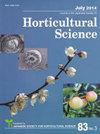Development of Molecular Markers Associated with Sexuality in Diospyros lotus L. and Their Application in D. kaki Thunb.
Journal of The Japanese Society for Horticultural Science
Pub Date : 2014-07-31
DOI:10.2503/JJSHS1.CH-109
引用次数: 26
Abstract
Sexuality of crops affects both cultivation and breeding systems. Cultivated persimmon (Diospyros kaki Thunb) has a morphologically well-characterized polygamous or gyonodioecious sexual system. However, the genetic basis of sexuality in D. kaki has yet to be characterized. Here, we used dioecious D. lotus L., a diploid wild relative species to hexaploid or nonaploid D. kaki, as a model to clarify the genetic basis of sexuality in Diospyros and to develop molecular markers associated with the sexuality of individuals. Using 62 F1 offspring segregated into distinct male/female phenotypes, we found two amplified fragment-length polymorphism markers, DlSx-AF4 and DlSx-AF7, which cosegregated with maleness. This could suggest that the sexuality of D. lotus is controlled by a single gene/haploblock, and the male is dominant over the female. Thus, D. lotus’s sexuality can be described as the heterogametic male type, the XY-type, as reported for most other dioecious plant species. For unknown reasons, segregation of the phenotype of a sequence-characterized amplified region marker developed from DlSx-AF4 (DlSx-AF4S) and/or the male/female phenotype in two different crosses in D. lotus showed an apparent bias towards femaleness and better fitted 1:2 than 1:1, which is the theoretical segregation for a single genetic locus or haploblock in diploid D. lotus. DlSx-AF4S could distinguish D. kaki cultivars with female and male flowers from cultivars with only female flowers, strongly indicating that the same genetic system controls D. kaki’s sexuality and that DlSx-AF4S could be used as a genetic marker for sexuality in D. kaki breeding programs.莲藕性相关分子标记的开发及其在枇杷中的应用。
作物的性向对栽培和育种系统都有影响。栽培柿子(Diospyros kaki Thunb)具有形态学特征良好的一夫多妻制或雌雄异株性系统。然而,雌雄同体的遗传基础尚未被确定。本研究以六倍体或非单倍体kaki的二倍体野生亲缘种雌雄异株D. lotusl .为模型,阐明了Diospyros性别的遗传基础,并开发了与个体性别相关的分子标记。利用62个不同雌雄表型的F1后代,我们发现两个片段长度多态性扩增标记DlSx-AF4和DlSx-AF7与雄性共分离。这可能表明荷花的性别是由一个单基因/单倍体块控制的,雄性比雌性占优势。因此,与大多数其他雌雄异株植物一样,荷花的性取向可以被描述为异交雄型,即xy型。由DlSx-AF4 (DlSx-AF4S)构建的序列特征扩增区标记的表型分离和/或两个不同杂交的雄性/雌性表型分离明显倾向于雌性,且1:2比1:1更适合,这是二倍体荷花中单个遗传位点或单倍体块的理论分离。DlSx-AF4S可以区分出雌雄花的山核桃品种和只有雌花的山核桃品种,这有力地说明了相同的遗传系统控制着山核桃的性向,并且可以作为山核桃育种中的性向遗传标记。
本文章由计算机程序翻译,如有差异,请以英文原文为准。
求助全文
约1分钟内获得全文
求助全文
来源期刊
自引率
0.00%
发文量
0
审稿时长
>36 weeks

 求助内容:
求助内容: 应助结果提醒方式:
应助结果提醒方式:


